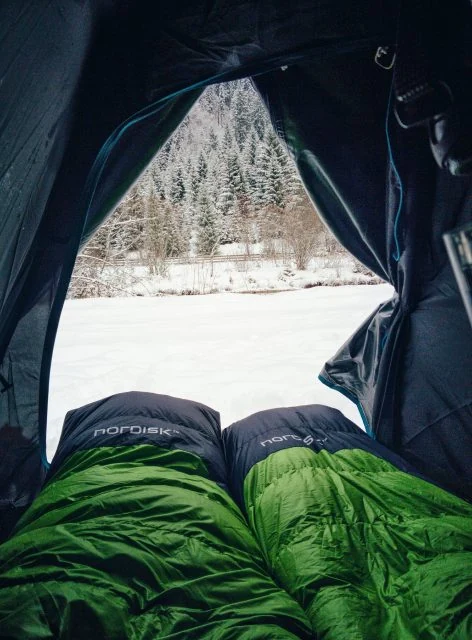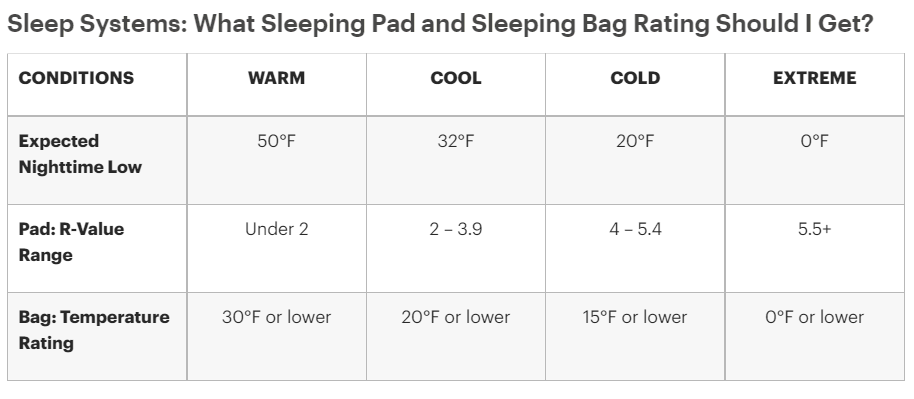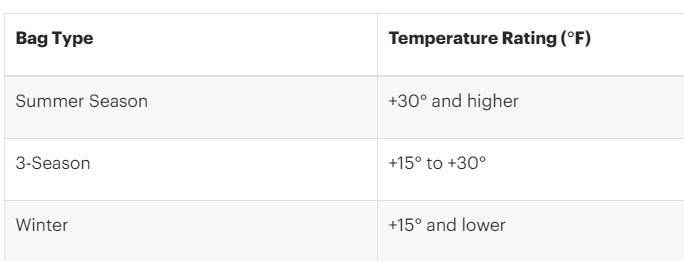When the weather can change rapidly in the wilderness, it’s important to be prepared. If you enjoy camping in nearly any forecast, you may find that you need a new sleeping bag that can withstand the elements. If so, you may be asking, “what does the temperature rating on a sleeping bag mean, anyway?”
Please read below for a thorough discussion of sleeping bag temperature ratings and what to expect when buying them.
What Does The Temperature Rating On A Sleeping Bag Mean?

The temperature rating of a sleeping bag tells you the lowest temperature that the bag can keep you comfortable while you sleep in it. For example, you might find a sleeping bag with a rating of 32 degrees F. This means it will be comfortable at a nightly temperature of 32 degrees F and higher.
Typically, you will see two different types of temperature ratings for sleeping bags, described below:
Comfort rating
The comfort rating indicates the temperature at which a “cold” sleeper might feel comfortable in this sleeping bag. Usually, women are “cold” sleepers compared to men, so this rating is the one you will find on sleeping bags designed for women.
More: Top 7 Best Rectangular Sleeping Bags
Lower limit rating
The lower limit temperature rating is the lowest temperature at which a “warm” sleeper (or a male) will still feel comfortable in this sleeping bag. This rating is found on men’s sleeping bags.
Still, confused? Here’s a youtube video explaining the comfort vs lower limit rating:
What Is A Good Temperature Rating For A Sleeping Bag?
The first step to determining the correct temperature for your sleeping bag is to assess whether you are a “cold” or “warm” sleeper. As we discussed in the previous section, typically, women are “cold” sleepers, while men are “warm” sleepers. This is because, in a given sleeping bag, generally the average woman will feel colder at night.
If you are a woman and feel that you are a “cold” sleeper, check the “comfort” rating. The comfort rating is the lowest temperature where the bag can keep a cold sleeper comfortable. However, if you are a man or a warm sleeper, check the “limit” or “lower limit” rating. This is the lowest temperature at which a warm sleeper will be comfortable in the sleeping bag.
More: 7 Best Backpacking Sleeping Bag Under $100 (Reviews and Buying Guide)
What Temperature Sleeping Bag Should I Get?
When selecting your sleeping bag, look for a bag that has a lower temperature rating than the lowest nightly temperature you can expect to face. This is important because the bag will be equipped to handle the coldest temperature, and you can always unzip it if you feel too warm.
In fact, it’s recommended to bring a bag that has a temperature rating at least 10 degrees F lower than the coldest temperature you will encounter on your camping trip.
If you want to use a sleeping bag you already have, though, you can make up for any temperature rating discrepancies with a sleeping pad.
With a sleeping pad, not only can you sleep on a more comfortable surface than the bare ground, but the sleeping pad provides a barrier between yourself and the moist, cold grass. Another option is a sleeping bag liner, which can make your sleeping bag 5 to 25 degrees F warmer.
More: The 5 Best Summer Sleeping Bags In The Market For Summer Camping
Overall, there is a range of sleeping bag temperature ratings to consider, as seen in the chart below.

Suppose you are planning to camp in a warmer environment where the nightly low temperatures won’t get down below 50 degrees F, for instance. In that case, you can choose a sleeping bag with a temperature rating of 30 degrees F. You can find summer sleeping bags with higher temperature ratings as well.
For cool spring or fall nights where the expected nightly lows are around 32 degrees F, you should choose a bag with a temperature rating of 20 degrees F or lower.
A sleeping bag that is built to withstand colder nightly lows (20 degrees F) will typically be rated for 15 degrees F or lower. For example, the NEMO Riff 15 is a cozy sleeping bag with a warm-down filling that is designed to keep the chills away.
However, on the more extreme end, if you will be sleeping in very cold 0 degrees F nightly temperatures, make sure that your bag has a temperature rating of 0 degrees F or less to match it.
For more simplicity, see this chart:

As the chart shows, sleeping bags intended for summer use will typically have a temperature rating of 30 degrees F (some may be higher). Conversely, 3-season sleeping bags (appropriate for summer, spring, and fall camping) usually are rated for 15 to 30 degrees F. Finally, winter sleeping bags will often have a temperature rating of 15 degrees F and below.
Here is another interpretation of a sleeping bag temperature rating chart. As you can see, it is similar to the one above, with slight variations.
< Temperature rating chart >
- Summer/low-elevation sleeping bags : 32°F and above
- 3-season sleeping bags : 20 to 32°F
- Cold-weather/winter sleeping bags : 20°F and below
Check out our guides for selecting a sleeping bag here: https://outdoorwithj.com/category/camping-hiking/sleeping-bag/
Are sleeping bag temperature ratings accurate?
To ensure that the sleeping bag has undergone standardized testing, check for one that is labeled with an “EN” (European Norm) or “ISO” (International Organization for Standardization) temperature rating. This means that the warmth of the sleeping bag has been subjected to specific, standardized testing so that you can successfully compare the temperature ratings.
The temperature rating itself is an estimate found via lab testing to simulate how a test manikin’s temperature responds to changes in temperature when inside the sleeping bag.
If the bag does not indicate “EN” or “ISO” testing, this means that the brand utilized its own estimation protocol for temperature ratings. This doesn’t necessarily mean it’s incorrect, but it may mean that it is trickier to compare its temperature rating to other bags.
While the EN or ISO designation indicates that the temperature ratings should be comparable between brands, it is not foolproof. Despite the standardized testing, the temperature rating does not guarantee the warmth of the bag.
Also, consider the type of clothing you’ll be sleeping in, your sleeping pad temperature rating, what type of tent you have, any extra blankets you’ll be using, and other factors that will affect how warm or cold you feel.
Furthermore, don’t count on the name of the bag to tell you the temperature rating. Many of them will round to a “catchier” number like 25 or 30 for the name of the bag, while the temperature rating itself might be 22 or 29 degrees. Tricky!
More: The Best Sleeping Bag For Hammock For Hammock Camping
Conclusion
As we’ve reviewed, the temperature rating is an estimation of the lowest temperature at which you will sleep without feeling cold. Women searching for a sleeping bag should look at the “comfort” rating, while men should assess the “lower limit” rating. Bags that have undergone standardized testing will be labeled with an “EN” or “ISO” rating, so look out for these.
Many sleeping bags meant for cold nights (such as the Nemo Riff 15) will be rated for 15 degrees F or below, while extreme bags will have a rating of 0 degrees F and below.
Sleeping bags meant for cooler night temperatures in the fall and spring will typically be rated around 20 degrees F, while summer sleeping bags will usually have a temperature rating near 30 degrees F.
Understanding the temperature rating of your sleeping bag can make a big difference in your camping experience. With the proper sleeping bag, you will be more comfortable when the night gets chilly.
If you have any more questions or concerns about sleeping bag temperature ratings, please leave a comment below!



